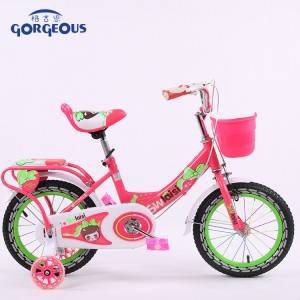Dec . 22, 2024 23:33 Back to list
sizes of balance bikes
The Sizes of Balance Bikes A Comprehensive Guide for Parents
Balance bikes have surged in popularity as an effective tool for teaching young children how to ride a bicycle. Unlike traditional training wheels, balance bikes promote the development of balance and coordination, allowing children to master these essential skills before progressing to a pedal bike. However, choosing the right balance bike can be challenging, particularly when it comes to size. In this article, we will explore the importance of selecting the correct size of a balance bike and provide guidance to help parents make the best choice for their children.
Understanding Balance Bike Sizes
Balance bikes come in various sizes, primarily determined by the child's inseam length and overall height. It's crucial to understand that these sizes are not standardized across brands, so it's essential to check the specifications for each bike model. The primary measurements to keep in mind are the seat height and the bike's weight.
When shopping for a balance bike, the seat height is the most critical factor. Adjustability is a significant benefit, as it allows the bike to grow with your child. Generally, the seat height should be set so that your child can comfortably place their feet on the ground while sitting on the saddle. This positioning enables them to push off the ground and maintain balance effectively.
How to Measure for the Right Size
To find the right size, measuring your child's inseam is essential. To do this, have your child stand barefoot with their feet slightly apart. Measure from the ground up to the crotch. Once you have this measurement, compare it with the balance bike's specifications. A good rule of thumb is to choose a bike whose minimum seat height is about 1-2 inches lower than your child's inseam. This difference allows for comfortable standing and mobility, ensuring a sense of security as they learn to balance.
Choosing the Right Size Based on Age and Height
sizes of balance bikes

While inseam measurement is paramount, it can also be helpful to consider your child's age and height. Generally, balance bikes are designed for children aged 18 months to 6 years. The chart below offers a rough guideline based on age and average height
- Ages 18 months to 2 years (Height 28-33 inches) Look for balance bikes with a seat height ranging from 11 to 14 inches. - Ages 2 to 3 years (Height 33-38 inches) A seat height between 14 to 16 inches is typically suitable. - Ages 3 to 5 years (Height 38-46 inches) Choose bikes with a seat height of about 16 to 20 inches. - Ages 4 to 6 years (Height 42-50 inches) The ideal seat height will be in the range of 18 to 22 inches.
Keep in mind that children grow at different rates, and age is only a rough guideline. Always prioritize the inseam measurement over age when choosing a balance bike.
Balancing Comfort and Functionality
Once you've determined the right size, consider other factors such as the weight of the bike, material, and features like the type of tires. A lightweight bike is easier for smaller children to maneuver, helping them gain confidence quickly. Additionally, consider adjustable features like seat height and handlebars, ensuring the bike can adapt as your child grows.
Conclusion
Selecting the right size balance bike is crucial for your child's success in learning to ride. By taking careful measurements and considering their height and age, you can find a bike that promotes confidence and balance without unnecessary frustration. A well-suited balance bike not only enhances the learning experience but also sets the foundation for a lifelong love of cycling. With the right tools, your child will soon be gliding along, mastering the art of balance before embarking on the next adventure of pedal biking. Happy riding!
-
Wooden Tricycle for Kids | Safe, Eco-Friendly Ride
NewsJul.31,2025
-
Wooden Tricycle for Kids - Vintage & Two Seater Options Wholesale
NewsJul.29,2025
-
Wooden Tricycle for Kids – Vintage & Two Seater Wholesale Options
NewsJul.28,2025
-
Premium Wooden Tricycle for Kids – Safe, Stylish, Two Seater Options
NewsJul.27,2025
-
Wooden Tricycle for Kids - Vintage & Two Seater Options, Wholesale Available
NewsJul.26,2025
-
Wooden Tricycle for Kids – Safe & Durable Rides for All Ages
NewsJul.25,2025
